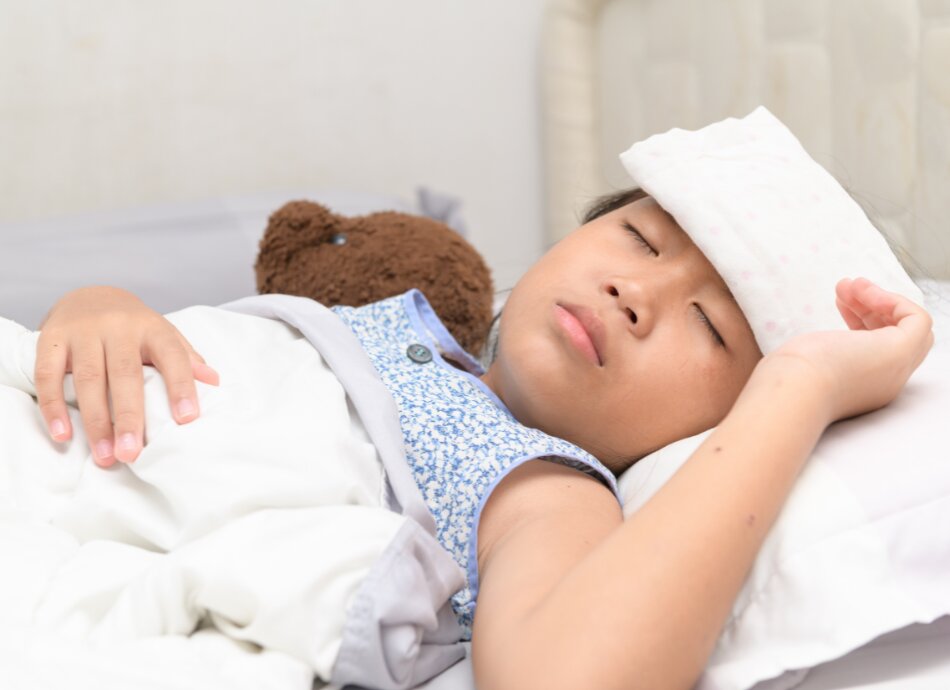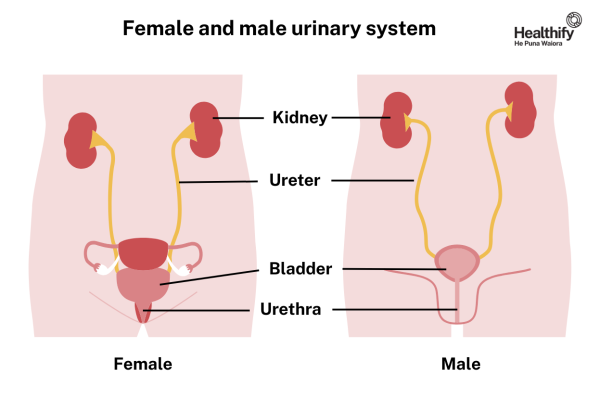Urinary tract infection (UTI) in children | Pokenga pūaha mimi
Key points about urinary tract infections in children
- A urinary tract infection (UTI) is an infection in the urine (wee).
- UTIs are common in tamariki and pēpi.
- Sometimes UTIs can make pēpi and young tamariki seriously ill.
- UTIs can cause tamariki to have a fever and become unwell.
- The content on this page comes from KidsHealth(external link).

The urinary tract is the kidneys, ureters, bladder, and urethra.
The kidneys filter and remove waste and water from the blood to produce urine. The urine travels from the kidneys down 2 narrow tubes called the ureters. The urine is then stored in the bladder.
When your child does a wee, urine flows out of the body through the urethra, a tube at the bottom of the bladder. The opening of the urethra is at the end of the penis in boys and in front of the vagina in girls.

Image credit: Healthify He Puna Waiora
UTIs are common. They can happen at any age.
There are some conditions which put pēpi and tamariki at higher risk of UTIs:
- wearing nappies
- constipation (problems in passing poo)
- a problem with their urinary tract
- neurological conditions where their bladder doesn't empty properly.
Symptoms in children
Tamariki with a UTI may have the following symptoms:
- fever (high temperature)
- vomiting (being sick)
- feeling generally unwell often with loss of appetite
- tummy pain
- pain when weeing
- wanting to wee frequently
- bedwetting or wetting during the day, if previously dry
- blood in their wee.
If you think your child has a UTI, see your healthcare provider or an after-hours medical centre.
Symptoms in babies and young children
Symptoms of a UTI in pēpi and young tamariki can include:
- fever (high temperature)
- irritability
- poor feeding
- vomiting (being sick)
- being very tired and lacking energy
- poor weight gain
- jaundice in newborn babies which continues for more than 2 weeks.
Sometimes a UTI can become more serious in young babies or children. The infection can spread to their kidneys, blood stream and brain.
If you are worried your baby has a UTI, see a healthcare provider urgently.
Diagnosis
Testing your child's urine is the only way to know for sure if they have a UTI. Your healthcare provider can arrange a urine test for your child.
Management
Antibiotics
Antibiotics are the main treatment for UTIs. Treatment is usually for 3 to 7 days. This depends on several factors, including how unwell your child is and whether they have underlying kidney problems.
Your child's symptoms should start to improve after 48 hours of antibiotic treatment.
Drinking more fluids
Encouraging your child to drink more fluid may help.
Paracetamol if needed
You can give pain relief (paracetamol) if your child is in discomfort. You must follow the dosage instructions on the bottle. It's dangerous to give more than the recommended dose. Here is a paracetamol dose calculator so you can work out how much to give them.
Some babies and children need to go to hospital
The following pēpi and tamariki with a UTI usually need to go to hospital to see if they need intravenous antibiotics (given directly into a vein):
- Pēpi under 3 months of age.
- Tamariki who are very unwell.
If your baby has had a UTI and is under 12 months of age, they may need further tests.
Renal ultrasound scan
The most common investigation is a renal ultrasound. This is to find out if there are any blockages and to check if the kidneys are normal in shape, size and position. Read more about renal ultrasounds(external link).
Other investigations
A small number of babies and children may need an MCU (micturating cysto-urethrogram) or a nuclear medicine scan. A specialist at the hospital needs to request these tests. Read more about MCU(external link) and nuclear medicine scans(external link).
UTIs can be difficult to prevent, but here are some things that may help.
Encourage good toilet habits
- Encourage your child to go to the toilet regularly when they feel the need. Tamariki who hold on a long time are more at risk of UTIs.
- Encourage your child to sit properly on the toilet with their feet on a stool so that they empty their bladder completely.
- Teach girls to wipe their bottoms from front to back rather than back to front.
Toilet training
Toilet training your child and getting them out of nappies can help reduce UTIs.
Learn more about toilet training.
Drink plenty of water
Make sure your child drinks plenty of water, especially during hot weather.
Credits: Content shared between HealthInfo Canterbury, KidsHealth and Healthify He Puna Waiora as part of a National Health Content Hub Collaborative.
Last reviewed:





